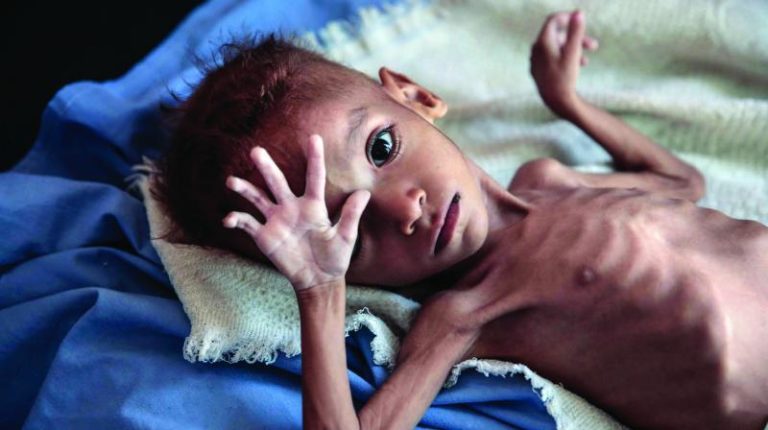According to World Health Organization, malnutrition is considered a cause of about 60% of deaths of children under the age of five years in resource constrained countries. Asia houses 70% of the world’s malnourished children. India accommodates 61 million malnourished, stunted children. Maternal and child undernutrition attributed to 11% of total global DALYs (disability-adjusted-life-years). Preschool-age and school children suffer from vitamin A deficiency (VAD). 84% of pregnant women in India and 70% of healthy Pakistani volunteers are affected by vitamin D deficiency (VDD). Intrauterine growth restriction (IUGR), iron-deficiency anemia (IDA), reduced cognitive performance, low birth weight, blindness is resulted due to undernutrition. The economic loss due to zinc deficiency amounts to 16 million global DALYs.
Prevalence of malnutrition in India
Malnutrition accounts for death at the rate of 87 per 1000 live births which amounts to 2.1 million child deaths in India. Girls aged 11-19 years manifested high protein-energy malnutrition (PEM). 43.8% of children reported marasmus and kwashiorkor whereas 8.7% suffered from severe malnutrition. Gender differences, family size, state of development of region affected the prevalence of malnutrition. Bihar, Madhya Pradesh, Orissa, Uttar Pradesh, Assam and Rajasthan exhibited low prevalence. Goa, Kerala and Punjab reported the least. Increased breastfeeding, oral rehydration therapy, complementary feeding curtailed child mortality rate.
Malnutrition- a Pakistan’s scenario
45.3 million people suffer from food insecurity. PEM, iodine and iron deficiencies result to 3-4% of Gross Domestic Product (GDP) loss each year. Studies revealed that stunting affected children aged 25 to 36 months with 42% of malnutrition cases.
Malnutrition hits Bangladesh children
The rural area corresponded 62.1% to 65.6% malnutrition cases while the urban area recorded 37.9% and 34.4% respectively. 0.4 million children under 5 years of age suffered from severe PEM. Millennium Development Goals aimed to reduce malnutrition to 34% by 2015. Restricted food intake, poor maternal and child-care practices are underlying causes. Fortification of micronutrients, deworming and good hygiene practices are required.
Malnutrition- a Srilankan perspective
47.2%, 28.5% and 2.2% of underweight, stunting and overweight were reported amongst adolescents that accounted for 21% of the population. A massive study assessing the health status of 2528 school children aged 9-10 years old reported 15.5% of children to be stunted, 52.6% thin, 3.1% overweight, 12.1% anemic and 0.3% having Bitot’s spots.
Malnutrition- a neglected study in Nepal
Seasonal food shortage, restricted availability of fruits and vegetables are the causes behind malnutrition leading to infant mortality rate of 118 out of 1,000 births. Deficiency of serum protein, serum folate and vitamin B are observed among malnourished children. Prevalence of stunting (45.57%) and underweight (52.46%) are reported to increase amongst tested boys and girls with no gender-based difference.
Malnutrition- hampering Afghanistan’s progress
41.9% of infants aged 6-12 months were stunted due to poor health care. High infant mortality (111 per 1000 live births) and child mortality rate (161 per 1000 live births) were reported in conjunction with malnutrition. 71.9% of school-aged children suffered from iodine deficiency in Kabul. 48.4% and 24.7% iron deficiency and anemia were reported in non-pregnant women while pregnant women accounted for 65.3 and 25.7% respectively. Food insecurity during winter (Dec-March) is a major obstacle.
Determinants for high prevalence of malnutrition in South Asia
Breast feeding
Lack of exclusive breastfeeding for a period of six months results in malnutrition. Breastfeeding reduces diarrheal infections which cause 1.34 million childhood deaths worldwide. Promoting birth spacing, adequate complementary feeding and preventing microbial contamination of weaning foods curtails malnutrition among infants.
Poverty
Malnutrition is resulted due to the inability to afford nutritionally rich foods. Earlier onset of malnutrition leads to poor fetal growth and adult health. Nutritional intervention is most prioritized during the first two years as improved nutrition can avoid permanent damage during the critical time.
Food security
Lack of accessibility of minerals and vitamins rich foods reinforces the likelihood of malaria, measles, diarrhea, pneumonia which eventually restricts the body from absorbing nutrients. Consumer price stabilization and income equality are important for food security.
Strategies to prevent and control malnutrition
Role of communities and individuals
Individual ensures household nutrition security and nutrition education. Public private partnerships, media campaigning, humanitarian services such as providing foods during natural calamities are important.
Women empowerment
Women’s own nutrition and childcare practices are closely linked to the nutritional status of family. Non-discriminatory social status empowers women. However, women in South Asia lag behind in education, mobility and decision making.
Health and sanitation
Untreated water and inappropriate disposal of human excreta and wastes increase likelihood of infection. Unavailability of treatments in pediatric hospitals are noticeable. Malnutrition is treated as outcome of poverty, social problem rather than health problem.
Food fortification programs
Consumption of fortified whole wheat flour has reduced iron deficiency. Iron-folate and multiple micronutrient fortifications have combatted early pregnancy.
Macroeconomic food policies
Poverty is not the only sole cause of malnutrition. Evidence is available to elucidate that the nations with a higher per capita gross national product (GNP) such as Indonesia comparing with China manifested higher prevalence of malnutrition. Similarly, Brazil with significant economic growth could not attenuate malnutrition in children less than 6 years of age over the past decade. Data collected under the Nutritional Surveillance Project in Bangladesh exhibited the impact of rice prices on children underweight. Studies conclude that macroeconomic food policies may be effective in reducing children underweight.
Reference to original paper
Akhtar, S. (2016). Malnutrition in South Asia—A Critical Reappraisal. Critical Reviews in Food Science and Nutrition, 56(14), 2320-2330. DOI: 10.1080/10408398.2013.832143








